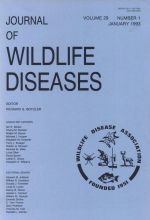Melody E. Roelke, Donald J. Forrester, Elliott R. Jacobson, George V. Kollias, Fred W. Scott, Margaret C. Barr, James F. Evermann, Eugene C. Pirtle
Journal of Wildlife Diseases 29 (1), 36-49, (1 January 1993) https://doi.org/10.7589/0090-3558-29.1.36

KEYWORDS: Florida panther, cougar, Felis concolor coryi, free-ranging, endangered species, serosurvey, Toxoplasma gondii, feline calicivirus, feline enteric coronavirus/feline infectious peritonitis virus, feline immunodeficiency virus/puma lentivirus, feline panleukopenia virus
Serum samples obtained from 38 free-ranging Florida panthers (Felis concolor coryi) in southern Florida, March 1978 through February 1991, were tested for antibodies against eight bacterial, parasitic, and viral disease agents. Sera were positive for antibodies against feline panleukopenia virus (FPV) (78%), feline calicivirus (56%), feline immunodeficiency virus/puma lentivirus (37%), feline enteric coronavirus/feline infectious peritonitis virus (19%), and Toxoplasma gondii (9%). All samples were seronegative for Brucella spp., feline rhinotracheitis virus, and pseudorabies virus. In addition, all the animals tested were negative for feline leukemia virus p27 antigen as determined by enzyme-linked immunosorbent assay. Feline panleukopenia virus was considered to be a potentially significant disease agent; FPV antibodies occurred in the highest prevalences in older age classes (P = 0.027) and in panthers living in the dense mixed hardwood swamps in the western portion of their range compared to the open cypress and sawgrass prairies to the east (P = 0.096). Because <50 animals remain in this relict population and the probable resultant depression of genetic diversity and lowered disease resistance, FPV or other disease agents could contribute to the extinction of this endangered subspecies.

